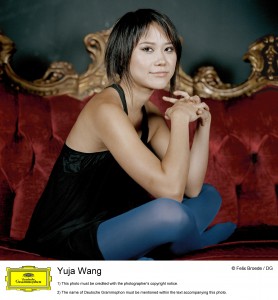|
Chamber
FRISSON DELIVERS SHIVERS OF DELIGHT
by Abby Wasserman
Sunday, March 30, 2025
Chamber
THE PARKER CAPTURES DEMANDING ADES QUARTET AT RAC SEBASTOPOL CONCERT
by Peter Lert
Saturday, February 15, 2025
Chamber
SPLENDID ECHOES ACROSS THE BAY
by Abby Wasserman
Sunday, February 9, 2025
ETHEREAL DUO IN WEILL HALL RECITAL
by Pamela Hicks Gailey
Thursday, February 6, 2025
ESPANA SEGURO AT SO CO PHIL'S JACKSON THEATER CONCERT
by Terry McNeill
Sunday, February 2, 2025
Choral and Vocal
MASTERFUL SINGING CLASS IN SCHROEDER HALL
by Pamela Hicks Gailey
Sunday, February 2, 2025
Recital
MUSICAL POT POURRI AT SPRING LAKE VILLAGE RECITAL
by Terry McNeill
Friday, January 31, 2025
CELLO AND CLARINET HIGHLIGHT TRIO NAVARRO'S CONCERT
by Ron Teplitz
Sunday, January 26, 2025
SONGS OF LOVE, IN A WARM TRIO
by Pamela Hicks Gailey
Sunday, January 26, 2025
Symphony
EARTHLY PLEASURES AT THE VALLEJO SYMPHONY
by Peter Lert
Sunday, January 19, 2025
|
 |
 Pianist Yuja Wang |
THE MAJESTIC INEVITABLE
by Steve Osborn
Thursday, March 7, 2013
The Beethoven Piano Concerto No. 4 is famous for beginning with a piano solo rather than the usual orchestral introduction. To use a literary term, it begins "in media res"--in the middle of things.
My experience of the San Francisco Symphony concert at the Green Music Center on March 7 likewise began "in media res," thanks to its poorly designed parking lot and the long line of people waiting to get in. The upshot was that I missed about half the opening work: "Drift and Providence," by the 26-year old American composer Samuel Adams, son of the famous minimalist composer John Adams.
Someday the Adams family may become as synonymous with American music making as the Bach family in Germany. Even though I heard only the latter half of "Drift and Providence," it is clearly an accomplished work by a composer of singular promise. The most notable element is the orchestration, for which the younger Adams has a natural gift. The various orchestral sections mingle with each other in complex and intertwining relationships, creating a density of sound that verges on the ethereal. The percussion is particularly distinctive, with many unusual instruments in the mix, including scraped brake drums and cow bells. A rare contrabass clarinet adds to the sonic panoply.
I hope to hear "Drift and Providence" in its entirety someday, but the opportunities may be few. In contrast, one has ample chance to hear Beethoven's fourth piano concerto, which received its second airing at the Green Music Center this season alone--the first was from Jeffrey Kahane at the opening concert last fall.
Here the soloist was Yuja Wang, a rising star in the classical music world, younger even than Samuel Adams. In contrast to Kahane, who plays with copious body English, Ms. Wang is a picture of restraint, hovering head-down over the keyboard and letting her elegantly sculpted arms and fingers do all the work. She generates tremendous power from her slim frame, and her fingers are a marvel of prestidigitation.
Ms. Wang played the concerto's magical opening chords with authority, immediately placing herself on an equal footing with the San Francisco Symphony, one of the world's great orchestras. Her interactions with the orchestra throughout the first movement were revelatory, each one fully articulating its lines and waiting for the other's response. The cadenza was outstanding. Under Ms. Wang's fingers, it had the intensity and complexity of one of Beethoven's late piano sonatas, a work unto itself.
Conductor Michael Tilson Thomas chose a remarkably slow tempo for the second movement, a pace that might have dragged other pianists down. But Ms. Wang turned the speed to her advantage, letting each note ring out with an unwavering beat. She entered the third movement at full speed, exchanging syncopated phrases with the orchestra in a delightful and ever-escalating call-and-response. The standing ovation at the end was both immediate and thunderous.
To fulfill the classic pattern of contemporary work, concerto, intermission, symphony, MTT chose the inexhaustible Brahms Symphony No. 1, a work so frequently performed that it has become almost an audition piece for measuring the capabilities of different orchestras. Given that the San Francisco Symphony is "auditioning" for a recurring series at the Green Music Center, they passed with flying colors. Their performance was, in a word, magnificent.
MTT started the proceedings with his trademark sweeping gestures, bringing forth a gorgeous unified sound that was both forceful and precise. An exceedingly ambidextrous conductor, MTT is both expressive and easy to read. He knows how to invest music with real drama, and he coaxes the most out of his superb musicians.
Each movement of the Brahms was better than the last. The first was dominated by the strings, who displayed remarkable dynamic control and coherent bowing. The winds carried the second, with its famous oboe solo. The third was silken smooth, the orchestra gliding along as if on a cloud. But the players, like Brahms, saved the best for last. The fourth began with strong pizzicato, a tremendous build-up, powerful brass, and then the majestic inevitable: an indelible theme as recognizable as Beethoven's "Ode to Joy."
The orchestra played throughout with tremendous energy and a deep appreciation of the score. Brahms may be ubiquitous, but that doesn't diminish the power of his music. If anything, it gets better on repeated hearing, particularly in performances as powerful as this one.
|
